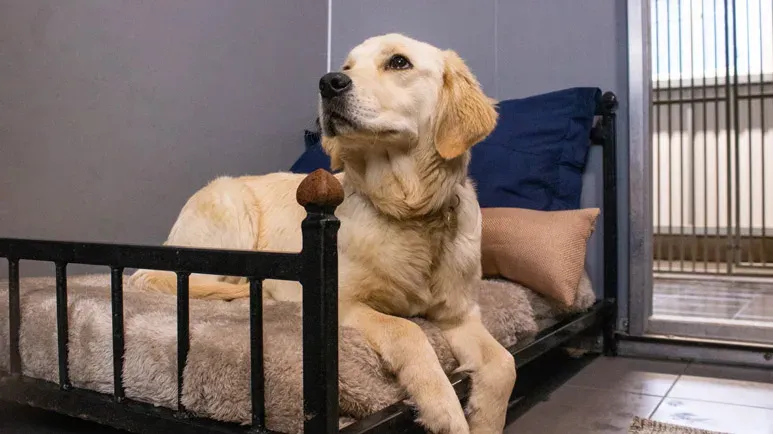Don't Leave Your Pet at a Boarding Facility Till You Read This
In 2015, a tragic event led to the deaths of 15 dogs. Sadly, it could've been avoided. Now many are pushing for new protective laws. In the meantime, here's what you should ask and look for before leaving your pet at any boarding facility. Does your standby have these traits?

STORY AT-A-GLANCE
- In 2015, 15 dogs died due to a fire that broke out at a boarding facility in Monterey, California
- While the facility had smoke alarms, it did not have a fire alarm, which would have signaled 911 to dispatch the fire department even if no one was there to report the fire
- A working fire alarm could have prevented the loss of life that occurred during this tragedy, yet there are no codes in place that require kennels to have such alarms
- A new bill was passed by the California Senate that would establish safety, sanitation, space and other rules for pet boarding facilities and introduce a fine system for violators
- Another alternative to pet daycare centers is hiring a pet sitter. Be sure to consider their past experience, as well as the referrals from past clients to ensure the safety of your pet
Editor's Note: This article is a reprint. It was originally published August 27, 2016.
In 2015, an air dryer used for drying fur at a pet spa, dog daycare and boarding facility was left on while the owner left for less than half an hour. In that time, a fire started at the Monterey, California location, leading to the death of 15 dogs due to smoke inhalation.
While the facility had smoke alarms, it did not have a fire alarm, which would have signaled 911 to dispatch the fire department, even if no one was there to report the fire.1
A working fire alarm could have prevented the loss of life that occurred during this tragedy, yet there are no codes in place that require kennels to have such alarms.
California Senate Passes Bill to Improve Pet Safety at Boarding Facilities
A Monterey-based organization called Citizens for Safe Boarding is pursuing safer pet boarding practices and conditions in the local area and beyond.
After the deadly fire, the group pushed for city officials to change city code to require monitored fire alarm systems in pet boarding facilities, a change officials said would take years.
The group has been working closely with the Monterey City Council and Senator Bill Monning and have made progress in other areas, however. For instance, the city council now supports a move that would require boarding facilities to post signs if no working alarm system was present.
Earlier this year, Monning introduced SB-945, a bill that would establish safety, sanitation, space and other rules for pet boarding facilities and introduce a fine system for violators. The first violation would cost facilities up to $250 while subsequent violations would result in a fine of up to $1,000.
The bill passed unanimously in the Senate and will move on to the Assembly. Citizens for Safe Boarding Member Rachael Zala told Kion Right Now:2
“After working in conjunction with Senator Bill Monning's office, we are overwhelmingly happy to hear pets from all over California will not only have a fighting chance in case of a fire, but also have a better standard of care in a boarding facility.”
Tips for Choosing a Boarding Facility for Your Pet
When choosing a boarding facility, whether it be for doggy daycare or an extended stay, many pet owners focus on factors like cleanliness and comfort. These are certainly important, but be sure you also ask about emergency plans.
Look for a facility that has both smoke and fire detectors in place, and that is monitored 24/7 to alert emergency services in the event of a fire or other disaster. Facilities should have an evacuation plan in place to get boarded pets out of harm’s way and to a safe alternative location quickly.
Other safety features to look for include security systems, fire extinguishers, sprinkler systems, and motion detectors (to alert staff if a pet gets loose or someone unauthorized enters the building after hours).
The facility should have either a night attendant or remote monitoring capabilities so that pets’ safety is being looked out for even after hours. Be sure to ask about the procedure for an after-hours emergency evacuation. In addition, you’ll also want to consider the following factors when choosing a boarding facility:3
- Is the staff knowledgeable and caring?
- Does each dog have access to an indoor-outdoor run and a schedule for exercise?
- Are dogs able to rest comfortably, off of a concrete floor?
- Are cats housed away from dogs?
- Is there enough space for cats to move around comfortably?
- How often are pets fed and can you provide your own food?
- Are veterinary services available?
- Is the facility clean, well-ventilated and kept at a comfortable temperature?
- Are outdoor areas protected from harsh weather conditions (sun, snow and rain)?
Alternatives to Boarding Facilities
Even under the best circumstances, typical boarding facilities are stressful for pets accustomed to living in the comfort of your home, and the chance of him contracting any number of contagious diseases is higher than if he stayed at home.
If you have a trusted family member who is already familiar with your pet, that can be a good option — but many people do not or may feel uncomfortable asking for such a large favor.
Hiring a pet sitter to care for your pet in your home can be a good happy medium, allowing your pet to maintain his familiar routine and bypass the stress of being sent to a strange boarding facility. Finding a responsible, qualified and caring pet sitter is crucial, however.
Referrals from friends, neighbors, family, your veterinarian or your dog trainer are often the best sources of pet sitters. You can also check for pet-sitting services in your area by searching online or contacting the National Association of Professional Pet Sitters or Pet Sitters International.
During your interview with your potential pet sitter, ask about past experience, what types of pets she’s cared for, and whether she’s completed any special training.
In addition, your pet sitter should be able to provide written proof of commercial liability insurance (in case of accidents) and should be bonded (to protect against theft). Be sure to also discuss communication; will your pet sitter text you written updates or photos daily?
You’ll also want to ask for references from past clients and carefully observe how she interacts with your pet in your home environment prior to your trip.
Boarding Facilities That Buck the Status Quo
With that in mind, it is possible to find boarding facilities that dogs enjoy. One that has set the bar very high is Your Dog’s Inn, which is a holistic doggy daycare that also offers boarding and grooming, located in Newburgh, Maine.
The owner, Elizabeth Miller, shared that her facility is based on what she believes Mother Nature intended for dogs, including daily activities that stimulate the body and mind, rest with other dogs, some obedience training, and exercise in the great outdoors.











